The Robe a la Francais
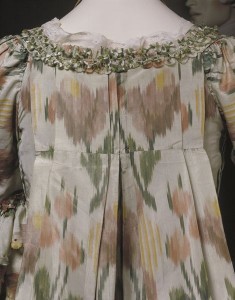 Alongside the Anglais, this garment was one of the statutory items that mark out 18th century costume. In it’s essential form it barely differs from the Robe a l’Anglais – technically, the pleats instead of being sewn down are allowed to hang loose. Now obviously the pleat allowance is vastly difference, as is their positioning on the CB but the actual garment construction and the way it was worn were virtually the same. You would have no problems if you skipped this page and opened instead the ‘How to Wear the Anglais’ page. The dressing is the same.
Alongside the Anglais, this garment was one of the statutory items that mark out 18th century costume. In it’s essential form it barely differs from the Robe a l’Anglais – technically, the pleats instead of being sewn down are allowed to hang loose. Now obviously the pleat allowance is vastly difference, as is their positioning on the CB but the actual garment construction and the way it was worn were virtually the same. You would have no problems if you skipped this page and opened instead the ‘How to Wear the Anglais’ page. The dressing is the same.
Having said all that, where their differences lie is in their fashions – especially in the mid section of the century. Though for a time the sack back form of dress was day wear (or Undress), it very steadily became Dress and Court Wear and out shone the humble Anglais. This tends to be their definite difference in the museums. Almost all of the Francais are silk and tend to come with stomacher and petticoat, saved through the years as an expensive articfact. They tended to have luscious trimmings, lace or furbelows and needed to use more fabric which adds to their importance.
Almost all of the Anglais in the museums are silk too – admittedly. But this is due more to the fact that the everyday wear of the Linen gown got downgraded and used up for childrens clothes and cloths while the wealthier day gowns, still made of silk, were kept. However, Anglais are less likely to have their Stomachers matching still with them, nor very often with their petticoats. It tends to be a fragile old looking thing that has seen more wear. This is a sweeping generalisation but it is the picture that seems to be representative in the museums we’ve been to.
Francais’ were somehow set apart for better fashions.
So, how to dress yourself…
* 1st Stage:
– First you need to get into your underclothes. We could leave you here with this simple statement but even this isn’t as easy as it sounds. 1st off it’s not
clear from the many images and paintings of the 18th century whether or not the petticoat was worn under or over the Stays. Man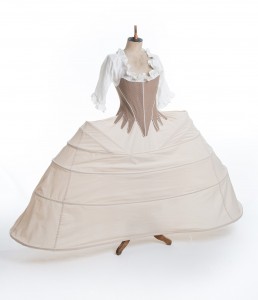 y of the images where a lady is in half dress she is pictured in a petticoat worn under the stays. It is often a problem that stomachers don’t sit so smoothly and flatly as they seem to supposed to when they go over the bump of the petticoat laced on over. Wearing the Stays over the petticoat would reduce that bump and leave a smooth area to dress the Stomacher onto. It could also explain why a lot (not all) of the stomachers are longer and larger than you’d imagine(And really not all of them – some are short and slender looking things). Modern Historians tend to dress the petticoat over the Stays (see Costumes Close Up by L.Baumgarten on p…..) which would makes sense to our understanding of corsetry being more of an underwear item. But this also fits in with the idea that lacing in a bulky petticoat would be particularly uncomfortable. This is an area we are still researching!
y of the images where a lady is in half dress she is pictured in a petticoat worn under the stays. It is often a problem that stomachers don’t sit so smoothly and flatly as they seem to supposed to when they go over the bump of the petticoat laced on over. Wearing the Stays over the petticoat would reduce that bump and leave a smooth area to dress the Stomacher onto. It could also explain why a lot (not all) of the stomachers are longer and larger than you’d imagine(And really not all of them – some are short and slender looking things). Modern Historians tend to dress the petticoat over the Stays (see Costumes Close Up by L.Baumgarten on p…..) which would makes sense to our understanding of corsetry being more of an underwear item. But this also fits in with the idea that lacing in a bulky petticoat would be particularly uncomfortable. This is an area we are still researching!
This is one of the moments you can tie on your pocket – you can do this over or under the petticoat. In our current understanding, it seems that the working women wore their pockets over the top of the petticoats as they had a much more functional use. Possibly wealthier ladies were able to wear them inside their hoops. Modern historians seem to place them under the petticoat.
Also tie on any additional Hip pads/Hooped Petticoats/Pocket Hoops that you may be desiring to wear. With this particular dress, you can get away with almost any style – there’s examples of them being worn without a hoop, with massive wide things, simple Hips pads etc etc. However, generally the period which Francais’ become more fashionable is when the wideness is more fashionable, possibly only wearing a thick Quilted Petticoat might be better reserved for the Anglais or humble gown.
We also advise that you put any boots or shoes that require more than just slipping into BEFORE you get into your Stays and hoop. Just keeping life simple!
* 2nd Stage: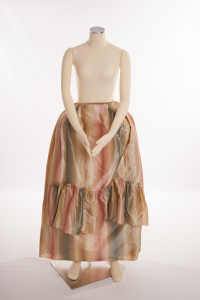
– Now that you are all corseted up, the next section is putting on the petticoat (unless of course you’ve already got it on!). Do this by stepping into the petticoat and bring the two back ties round to the front and fasten. Then bring the front two ties round to the back and fasten. You can gain access into your pockets through the side slits if you are wearing them in this position.
* 3rd Stage:
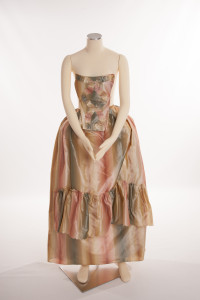 – Over your petticoat now you are about to pin on the Stomacher. If you ordered your dress with a hook and eye option please ignore this stage.
– Over your petticoat now you are about to pin on the Stomacher. If you ordered your dress with a hook and eye option please ignore this stage.
The use of pinning is rather useful. If you fancy wearing your stays a bit looser you can. If you have put on weight; fine. If you infact feel far slimmer today then this is also fine. Because the garment is pinned on it can be taken in or let out easily enough. The pinning starts here with the putting on of the Stomacher.
Some ground rules:
– Please remember when you are trying this that this will get better with practise!
– Do not try this really without Stays on. The use of Stays means that the way you move and what you are pinning onto should generally not allow you to stab yourself! If you don’t have stays on we have a problem. The answer: probably don’t pin!
– Use as many as you feel comfortable with – not the more the better; we don’t want you setting of metal detectors, but certainly don’t only use 2!
– In the pressing in of the pins try and get a good downward motion and make sure you can come back up, out of the fabric.
– Don’t Panic! By the time you finish pinning you will soon be able to tell the ones that didn’t catch right. Just re-do them.
Place your stomacher evenly over the centre of your Stays, making it a little higher than your Stays so that it hides them, you don’t really want to be seeing the edge. It only needs to sit a little higher though, don’t go choking yourself! Once in place begin to slide pins in at either side of the stomacher, into your Stays and catching the fabric over the top of the boning. If you are wearing your petticoat over then you can also pin into th e waistband easily enough.We put about 5 either side, if that helps.
e waistband easily enough.We put about 5 either side, if that helps.
* 4th Stage:
– Next is the pulling on of the outer robe. If you have someone helping you then this is fairly straight forward. You pull the robe on like a jacket but your helper is able to hold down the sleeves of your shift while you do this. This makes a big difference. Depending which year the sack back is based on is depending on how large and baggy the sleeves are and therefore how easy they are to get on. This particular robe has been based on a design after from the 1760’s where the sleeves begin to be a bit more fitted. This means that it is hard work wriggling down the shift sleeve. If you are on your own don’t p anic, we do have a solution. (Well done by the way for getting into your stays all by yourself – give yourself a pat on the back!)
anic, we do have a solution. (Well done by the way for getting into your stays all by yourself – give yourself a pat on the back!)
What we have found useful is a piece of tape with a good quality safety pin attached to it. Please make sure it’s good quality as it can be rather painful if it bends, breaks or comes undone while you are midway this procedure. But, very simply, once one arm has been safely put on (you tend to only need to do the one side as you can dress one half a bit more cleverly and therefore avoid the rucking), pin your shift sleeve and hold onto the rest of the tape with the same hand as the side you’ve just pinned. Slide you hand through the sleeve of your dress and and keeping the tape taut, you can then pull the sleeve up. This tautness holds the shift sleeve down from serious rucking and although you will still have to do a little bit of digging to pull the shift out all neatly, it is much, much easier.
With your robe on, next you will need to lay the robings down over the stomacher and begin to pin yourself in. This is easy enough if the robings lift 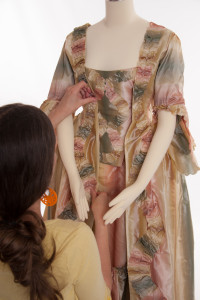 up. The original dress in the V&A features robings, which are double, but which are sewn down. We don’t know if this is something that has been altered over the years or is an original feature. However it makes it very difficult to pin down. But the fact is that the stomacher bears two lines worth of pin marks so it was definitely pinned down. For this gown you will need to carefully pin down just on the under side of the Robings. It is fiddly and will need patience to get each pin well hidden. If you have decided to opt for the open Robings that lift up then you’re life has just suddenly gotten easier.
up. The original dress in the V&A features robings, which are double, but which are sewn down. We don’t know if this is something that has been altered over the years or is an original feature. However it makes it very difficult to pin down. But the fact is that the stomacher bears two lines worth of pin marks so it was definitely pinned down. For this gown you will need to carefully pin down just on the under side of the Robings. It is fiddly and will need patience to get each pin well hidden. If you have decided to opt for the open Robings that lift up then you’re life has just suddenly gotten easier.
Once this is done you are dressed!
We do hope you have fun with your costume and any questions please feel free to ask!



